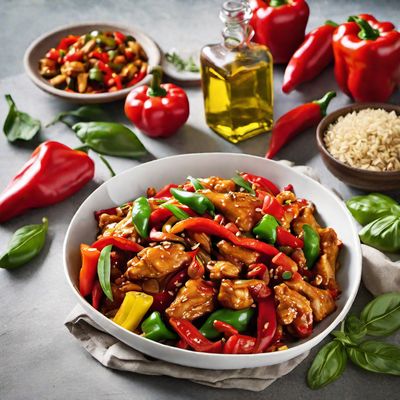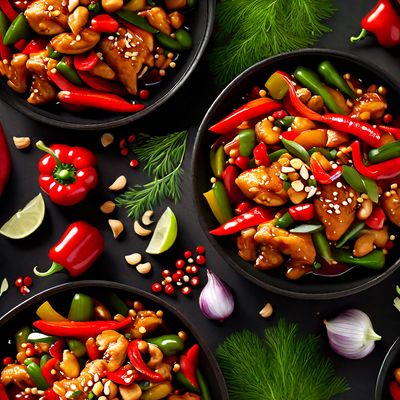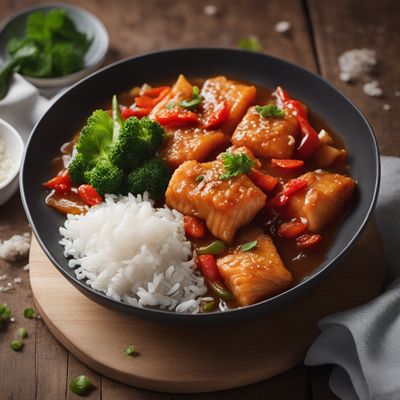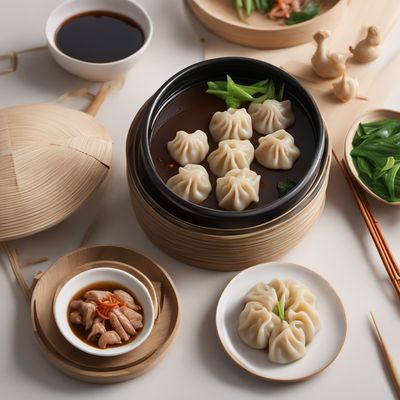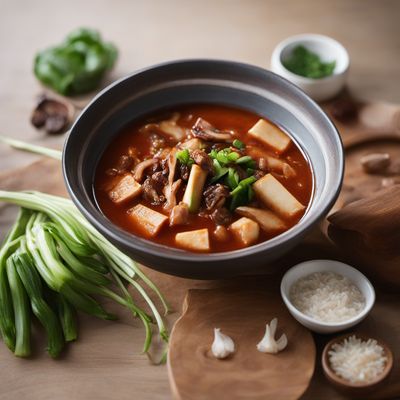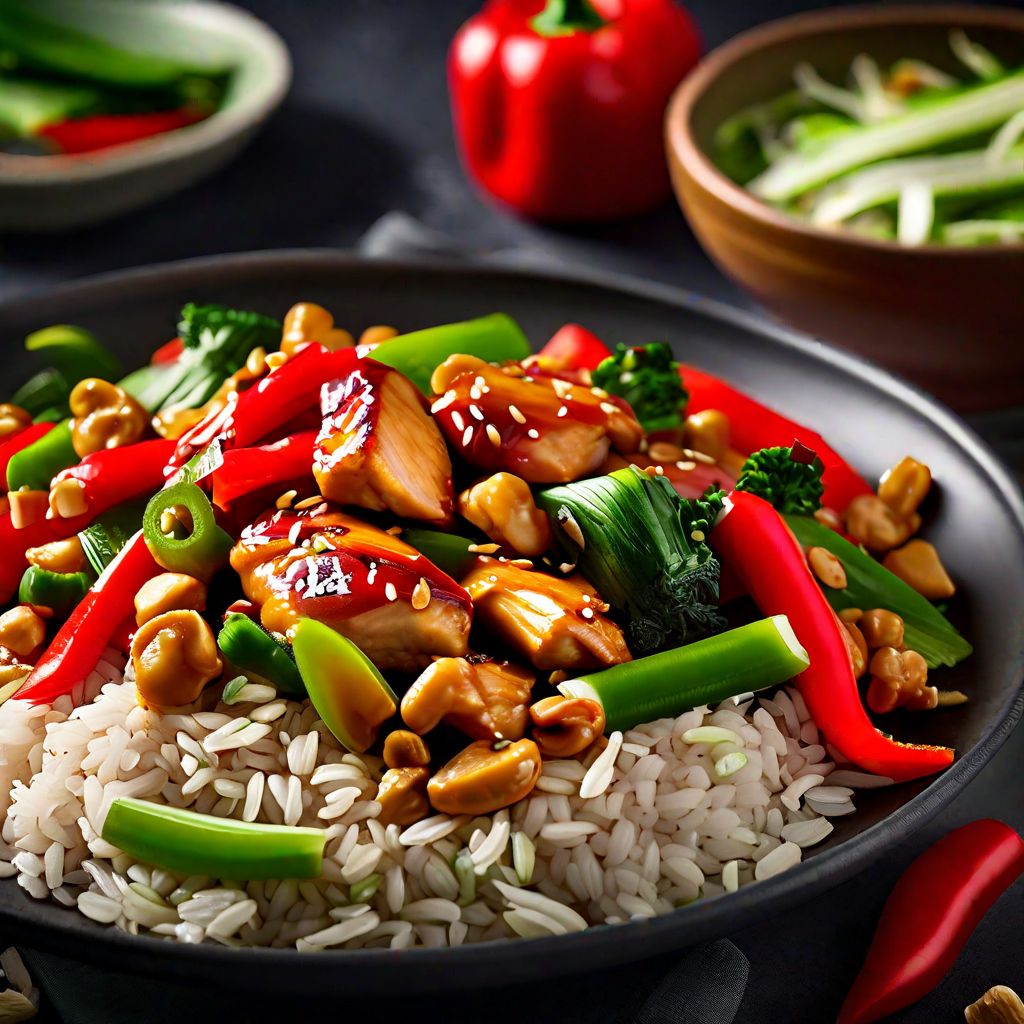
Recipe
Kung Pao Chicken
Spicy Korean-style Kung Pao Chicken
4.8 out of 5
In Korean cuisine, bold flavors and spicy dishes are highly cherished. This adaptation of the classic Chinese Kung Pao Chicken brings together the best of both worlds. The dish combines tender chicken, crunchy vegetables, and a fiery sauce that will leave your taste buds tingling with delight. Get ready to experience a mouthwatering explosion of flavors!
Metadata
Preparation time
40 minutes
Cooking time
15 minutes
Total time
55 minutes
Yields
4 servings
Preparation difficulty
Medium
Suitable for
Gluten-free, Dairy-free, Nut-free, Low-carb, High-protein
Allergens
Peanuts
Not suitable for
Vegan, Vegetarian, Paleo, Keto, Pescatarian
Ingredients
While the original Chinese Kung Pao Chicken is known for its Sichuan peppercorns and peanuts, this Korean adaptation adds a unique twist. The sauce incorporates gochujang, a spicy fermented chili paste, which gives the dish a distinct Korean flavor. Additionally, traditional Korean vegetables like daikon radish and Korean chili peppers are used to enhance the dish's spiciness. We alse have the original recipe for Kung Pao Chicken, so you can check it out.
-
500g (1.1 lb) boneless, skinless chicken breasts, cut into bite-sized pieces 500g (1.1 lb) boneless, skinless chicken breasts, cut into bite-sized pieces
-
2 tablespoons vegetable oil 2 tablespoons vegetable oil
-
1 onion, diced 1 onion, diced
-
2 cloves garlic, minced 2 cloves garlic, minced
-
1 red bell pepper, diced 1 red bell pepper, diced
-
1 green bell pepper, diced 1 green bell pepper, diced
-
1 small daikon radish, peeled and thinly sliced 1 small daikon radish, peeled and thinly sliced
-
2 Korean chili peppers, thinly sliced 2 Korean chili peppers, thinly sliced
-
1/2 cup roasted peanuts 1/2 cup roasted peanuts
-
2 green onions, chopped 2 green onions, chopped
-
For the marinade: For the marinade:
-
2 tablespoons soy sauce 2 tablespoons soy sauce
-
1 tablespoon rice vinegar 1 tablespoon rice vinegar
-
1 tablespoon gochujang 1 tablespoon gochujang
-
1 tablespoon honey 1 tablespoon honey
-
1 teaspoon sesame oil 1 teaspoon sesame oil
-
1 teaspoon grated ginger 1 teaspoon grated ginger
-
For the sauce: For the sauce:
-
3 tablespoons soy sauce 3 tablespoons soy sauce
-
2 tablespoons rice vinegar 2 tablespoons rice vinegar
-
2 tablespoons gochujang 2 tablespoons gochujang
-
1 tablespoon honey 1 tablespoon honey
-
1 tablespoon cornstarch 1 tablespoon cornstarch
-
1/4 cup water 1/4 cup water
Nutrition
- Calories (kcal / KJ): 350 kcal / 1465 KJ
- Fat (total, saturated): 15g, 2g
- Carbohydrates (total, sugars): 20g, 8g
- Protein: 30g
- Fiber: 4g
- Salt: 1.5g
Preparation
-
1.In a bowl, combine all the marinade ingredients. Add the chicken pieces and toss to coat. Let it marinate for at least 30 minutes.
-
2.In a separate bowl, whisk together the sauce ingredients: soy sauce, rice vinegar, gochujang, honey, cornstarch, and water. Set aside.
-
3.Heat the vegetable oil in a large skillet or wok over medium-high heat. Add the marinated chicken and cook until browned and cooked through. Remove the chicken from the skillet and set aside.
-
4.In the same skillet, add the diced onion, minced garlic, red and green bell peppers, daikon radish, and Korean chili peppers. Stir-fry for 3-4 minutes until the vegetables are slightly tender.
-
5.Return the cooked chicken to the skillet and pour in the prepared sauce. Stir well to coat the chicken and vegetables with the sauce. Cook for an additional 2-3 minutes until the sauce thickens.
-
6.Add the roasted peanuts and chopped green onions. Stir to combine.
-
7.Remove from heat and serve the spicy Korean-style Kung Pao Chicken hot with steamed rice.
Treat your ingredients with care...
- Chicken — Ensure the chicken is cut into bite-sized pieces for even cooking.
- Gochujang — Adjust the amount of gochujang according to your spice preference. Add more for extra heat.
- Daikon radish — Slice the daikon radish thinly to ensure it cooks quickly and retains a slight crunch.
- Korean chili peppers — Be cautious when handling Korean chili peppers as they can be very spicy. Remove the seeds for a milder flavor.
- Roasted peanuts — Use unsalted roasted peanuts for a healthier option.
Tips & Tricks
- For an extra kick of flavor, add a tablespoon of Korean sesame oil to the sauce.
- If you prefer a thicker sauce, increase the amount of cornstarch in the sauce mixture.
- Customize the dish by adding other vegetables like mushrooms or zucchini.
- Serve the Kung Pao Chicken with a side of kimchi for an authentic Korean experience.
- Adjust the spiciness by adding more or less gochujang according to your taste.
Serving advice
Serve the spicy Korean-style Kung Pao Chicken hot over steamed rice. Garnish with additional chopped green onions for a fresh touch. Pair it with a side of kimchi to balance the flavors.
Presentation advice
Arrange the Kung Pao Chicken on a large serving platter, allowing the vibrant colors of the vegetables to shine through. Sprinkle some crushed roasted peanuts on top for added texture. Serve with a bowl of steamed rice on the side.
More recipes...
More Chinese cuisine dishes » Browse all

Shumai
Shumai is a Chinese dim sum dish that consists of small, open-faced dumplings filled with a mixture of ground pork, shrimp, and seasonings. It is...
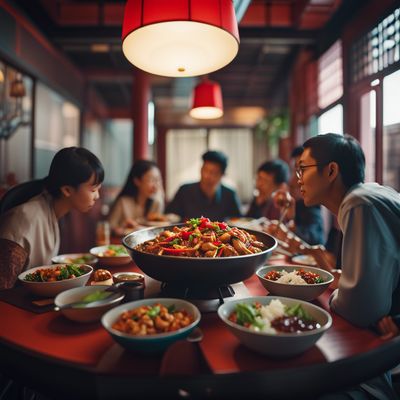
Kung Pao Chicken
Kung Pao Chicken is a classic Sichuan dish that is known for its spicy and savory flavors. The dish is made by stir-frying chicken with vegetables...

Mapo doufu
Mapo tofu
Mapo doufu is a popular Chinese dish that originated in the Sichuan province. It is a spicy and flavorful dish that is made with tofu and ground pork.
More Korean cuisine dishes » Browse all
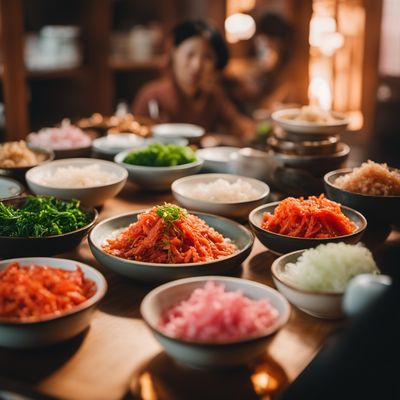
Kkakdugi
Kkakdugi is a traditional Korean side dish made from fermented radish. It is similar to baechu-kimchi, but has a milder flavor and a crunchier texture.
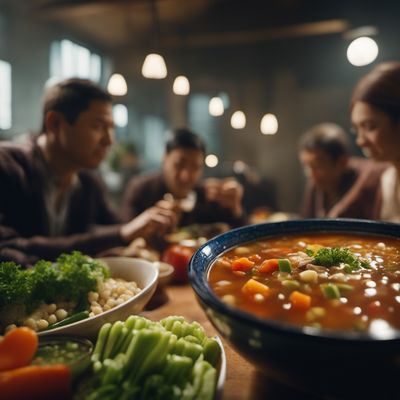
Soyo
Beef and vegetable soup
Soyo is a Korean soup made with soybean paste and vegetables.

Agujjim
Spicy Grilled Fish
Agujjim is a spicy Korean fish stew that is perfect for a cold winter day. It is a hearty and flavorful dish that is sure to warm you up.

